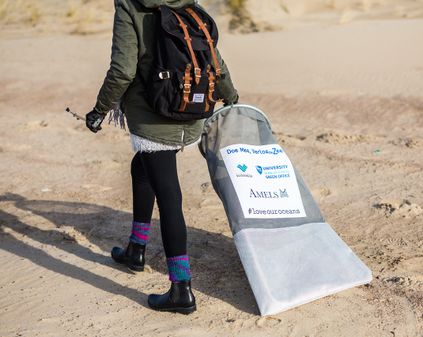Inner Harbour of Vlissingen
Ah, the Inner Harbour of Vlissingen - Jan's Arch Nemesis! No matter where you look, there's trash. What started as a spite-driven project after our initial monitoring with Lorenzo has turned into a major clean-up effort. Many students got involved, and even harbour workers started noticing the problem
Lorenzo also placed a camera at the harbour bottom - no ground in sight, just trash! His work led to a detailed litter report for the Municipality of Vlissingen.
Tackling the Issue: Step by Step
Convenant Clean Scheldt - Our clean-ups support HZ's commitment to the Covenant Clean Scheldt, uniting 34 organisations to protect the river. This collaboration now includes Doe Mee Verlos de Zee, Rijkswaterstaat, the Province of Zeeland, and the Municipality of Vlissingen. Progress is slow, but we're getting there!
Smarter Monitoring - Initially, we used the OSPAR method (an 8-page list - yikes!). We streamlined it into a one-page tally list to record litter while collecting it. See our monitoring list here: Inner Harbour Litter Monitoring List
Why It's a Big Deal - If the harbour were a closed system, it wouldn't be so concerning... but it's not! Water (and trash) flows freely from the harbour → Scheldt → Middelburg → Veere and beyond. Meanwhile, wildlife thrives here - fish, birds, even rabbits - all affected by litter, oil leaks, noise, and pollution from passing ships.
Hotspots: Where Trash Piles Up
We monitor five key areas, twice per academic year:
- The Lock: Tidal waterworks & grassy corners.
- Piet Heinkade (DAMEN Corner): A downwind collection spot.
- Red Bridge Corner: Near a busy roads - birds flock here.
- Inner Harbour 1: Once home to rabbits rulling the west shore.
- Inner Harbour 2: Fishing industry hub.
The Main Culprits
#1 Polluter: The Fishing Industry - The biggest offenders? Vispluis (loose fishing nets) and polystyrene packaging - it breaks apart like snow and spreads everywhere.
#2 Single-Use Waste - Plastic bottles, cans, and wrappers dominate.
Other common items: Cigarette butts, lighters, zip ties, facemasks, and... random single shoes (we've found six, but never a pair!).
We're committed to making the Inner Harbour cleaner - once cleanup at a time. Want to join the fight? Get involved!
Research Done
To get all this information, through research was done by several students, includign Pjotr Carelse, who did research on the plastic litter in the port of Vlissingen. You can find his research here.

